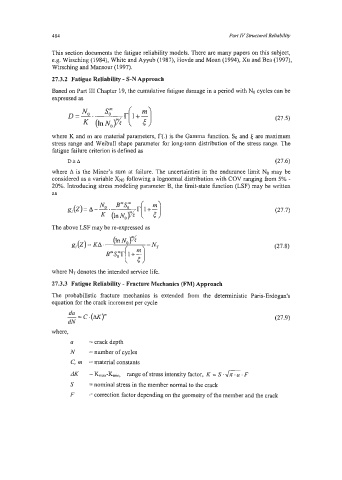Page 508 - Marine Structural Design
P. 508
484 Part IVStructural Reliability
This section documents the fatigue reliability models. There are many papers on this subject,
e.g. Wirsching (1984), White and Ayyub (1987), Hovde and Moan (1994), Xu and Bea (1997),
Wirsching and Mansour (1 997).
27.3.2 Fatigue Reliability - S-N Approach
Based on Part III Chapter 19, the cumulative fatigue damage in a period with NO cycles can be
expressed as
(27.5)
where K and m are material parameters, r(.) is the Gamma function. SO and are maximum
stress range and Weibull shape parameter for long-term distribution of the stress range. The
fatigue failure criterion is defined as
D2A (27.6)
where A is the Miner's sum at failure. The uncertainties in the endurance limit NO may be
considered as a variable XNO following a lognormal distribution with COV ranging from 5% -
20%. Introducing stress modeling parameter B, the limit-state function (LSF) may be written
as
No B"S,"
g,(Z) = A - -. (27.7)
K (In No )%
The above LSF may be re-expressed as
(27.8)
where NT denotes the intended service life.
27.3.3 Fatigue Reliability - Fracture Mechanics (FM) Approach
The probabilistic fracture mechanics is extended from the deterministic Paris-Erdogan's
equation for the crack increment per cycle
da
=
- C. (M)" (27.9)
dN
where,
a = crack depth
N = number of cycles
C, in = material constants
AK = Kmx-Kmin, range of stress intensity factor, K = S F
S = nominal stress in the member normal to the crack
F = correction factor depending on the geometry of the member and the crack

